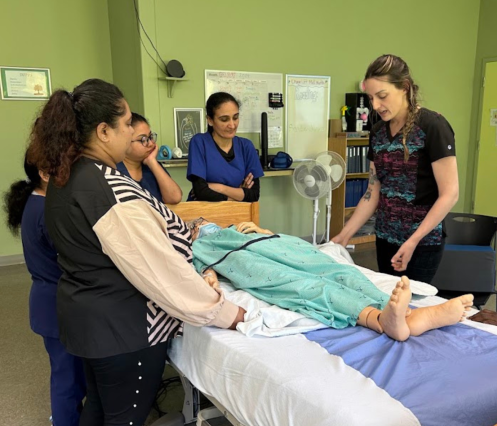Body mechanics training helps internationally educated nurses work safely

Internationally educated nurses (IENs) working for VON Nova Scotia recently took part in body mechanics training sessions through VON’s occupational therapy (OT) pilot program. The OT program offers support and professional recommendations to employees to help prevent workplace injuries.
VON has partnered with Atlantic Jobs to recruit internationally educated nurses (IENs) from India, South Africa and the Philippines. They then work as continuing care assistants (CCAs) for VON Nova Scotia, some with the goal of becoming registered nurses in Canada.
The first candidate arrived in November of 2020. Since then, Taylor Swinimer, International Transition Support Coordinator, noticed a need for additional education around body mechanics to help IENs more safely perform the physically demanding work required of CCAs.
“We worked together with our OT to develop some education for IENs geared towards their safety and client safety,” says Taylor. “Body mechanics was that course and it really helped teach the IENs how to properly give care and to move their body when they're giving that care.”
OT Amanda Bradshaw says home care workers experience higher rates of job-related injuries. “Home care is like a box of chocolates, because every single visit, you never know what's going to happen,” she says. “You're in someone's home, not a controlled environment like you get in a medical facility.”
For patients who require physical assistance, healthcare workers in a facility might have access to a lift or the support of a colleague. The room is likely to be laid out with the bed in the centre, making it easier to access the patient. In a home setting, workers are often alone, the physical layout is never the same and there are many variables that can influence care delivery.
“There are body mechanics principles that make things easier to do, lower your risk of injuring yourself and reduce the inherent wear and tear on your body over time,” Amanda says.
The client safe handling and mobility sessions took place in Annapolis Valley, Truro and Pictou, with 27 staff participating. In the sessions, Amanda shared methods for safe client handling and discussed available equipment and how to use it effectively.
She also encouraged participants to communicate with managers or co-workers when more equipment might be needed or if they experience difficulties at a particular home or aggravate an existing injury.
“With the IENs receiving that additional education, I've noticed they're bringing up concerns that they wouldn't have before,” says Taylor. “They're working safer and they know the resources that are available to them.”
All participants who completed surveys following the sessions noted the experience to be a positive one, and some requested additional one-on-one support. “The IENs were a very energetic group,” says Amanda. “They were very keen to learn. They had a lot of questions and jumped on the chance to get up and try things.”
Lori Snow, Project Coordinator, says the workshops are a great fit within the overall OT pilot. “Supporting the IENs is just one of the many ways the OT pilot, or what we like to call the Employee Support Program, has been able to support staff safety and confidence when caring for our clients,” she says.
Front-line employees across home care agencies in the northern and western zones of Nova Scotia have access to education and support from an OT through the pilot program, which is funded by a grant from the Department of Seniors and Long-Term Care.


